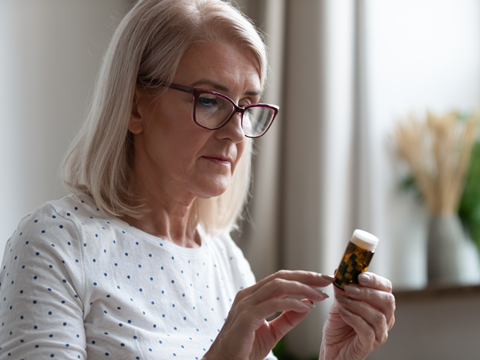
A survey from the Swedish Rheumatism Association reveals how elderly and disabled consumers can struggle to take medicine in inaccessible packaging – resorting to opening packs with their teeth or a tool, repackaging their medication, or skipping dosages altogether.
The open member survey was conducted through mailings and the Swedish Rheumatism Association’s website; it was also distributed by other patient and pensioner organizations. The Association emphasizes that the survey is ‘not statistically reliable but should be seen as an indication of how the handling of pharmaceutical packaging may be perceived by the organizations’ members.’
Of the 2,245 respondents, 92% sometimes have difficulty opening medicine packages, with 22% struggling daily.
“Even though the survey was aimed at people who may have difficulty with hand mobility, we find this figure remarkable,” says Lotta Håkansson, president of the Swedish Rheumatism Association. “At the same time, this is a group that often needs medication every day.”
Among the most difficult-to-open packaging designs in the respondents’ experiences are blister packs; bottles and pipettes for eye drops; medicine jars with a ring of space as an internal protective barrier; and child-resistant medicine jars that can only be opened by pushing and twisting the lid simultaneously.
When struggling to open a pack, 39% of respondents say they ask a family member for help. Another 3% turn to a pharmacist, while only 1% ask their neighbours for help. If they cannot access their medication with their hands, 5% of respondents use their teeth.
Respondent Katarina Järvborn explains that, due to her juvenile idiopathic arthritis (JIA), she needs help opening the packaging for her daily medication.

“There have been times when I have injured myself trying to open medicine packages with my hands,” she says. “I used to use my teeth to open them, but now I have a prosthetic jaw on the right side, which means I can’t move my jaw like before.”
An alternative method is to use tools available in a consumer’s home, which 38% of respondents say they have done. Their options include knives (28%), scissors (28%), pliers (21%), and screwdrivers (4%).
Whatever the method, 25% of respondents have previously been injured while trying to access a medicine pack, although only 1% say they required medical attention for their injury.
While aids are available for disabled consumers, and 11% of respondents say they use assistive devices when they cannot open a pack, Håkansson points out that finding a suitable solution can be difficult for some.
“It’s not so easy, for example, for elderly people with weak hands to Google around online and order blister openers or whatever it is they need,” she warns. “Many live alone and do not know where to turn for help.
“Of course, it is crucial that packaging is child resistant. But we also need to make sure that older people can open their medicine packs.”
Even once a pack is open, consumers with limited mobility must consider future uses. Some respondents discuss leaving their packaging open (31%) or pouring it into a different container for future convenience (26%) – Järvbom states that “in the past, when I had small children, I used a dosette box to take medicine myself, without having to have another adult present to open the packaging” – yet this comes at the expense of any childproof features built into the original pack.
Most respondents (41%) say they simply reseal the pack and hope they can open it themselves next time they take their medication. However, 14% of respondents have previously failed to take their medicine because they could not open its packaging – and, of this figure, 48% suffered impacts on their health.
Some respondents provided quotes detailing their difficulties with medicine packaging. One individual with osteoarthritis in their fingers says it “hurts like hell” to push tablets out of a blister.
“For me, the problem lies in all blister packs,” another respondent said. “I have an ‘expander’ but it is still a pain and time-consuming. Usually, the medicine is also available in a can, but then it is not included in the high-cost protection.”
One respondent adds that they “have problems with many packages and have been forced to switch to getting my medication in dose sachets.”
Sarah, a member of the Research Institute for Disabled Consumers (RiDC) Consumer Panel living with complex disabilities, previously spoke to Packaging Europe about using keys, pens, or sharp edges of jewellery to open medical packaging and refreshments outside the house. She describes the inner layer of a pack as the hardest part to open and says she misses the independence that comes with opening packaging by herself.
To overcome these issues, she encouraged packaging designers to recruit disabled people in the testing and feedback phases, or to simulate disabilities by attempting to open a pack one-handed or with taped-up fingers.
On World Braille Day 2024, Steven Brownett-Gale, marketing lead at Origin, shared his view of the right steps towards accessible pharmaceutical packaging. He asserted that every pack should be simple and easy to use without sacrificing child safety; and that the various needs and capabilities of a disabled patient should be considered, while the user should be given ‘integrity and independence in managing their own health’.
Our senior writer, Victoria Hattersley, has also hosted a podcast in conversation with Gordon McCulloch and Allan Mabert from the RiDC to gauge the packaging industry’s general progress in accessible design, and what it can still do to improve.
If you liked this story, you might also enjoy:
The ultimate guide to the Packaging and Packaging Waste Regulation in 2024
How are the top brands progressing on packaging sustainability?
Sustainable Innovation Report 2024: Current trends and future priorities
Everything you need to know about global plastic sustainability regulation











No comments yet